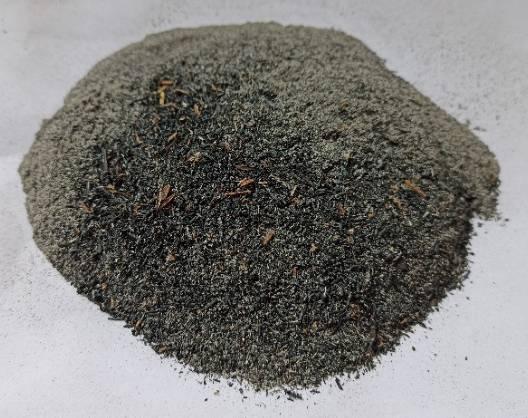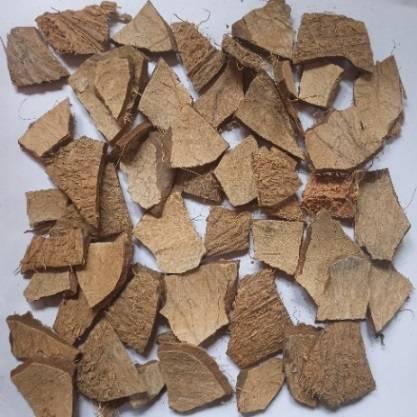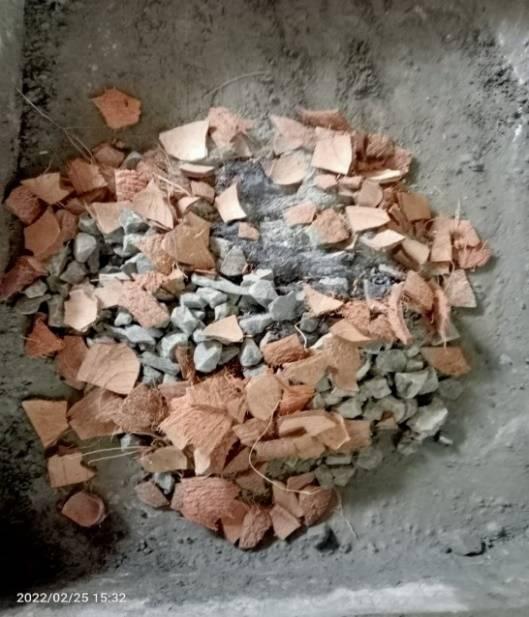
4 minute read
Results showed a rise in compressive strength at
For Control Mix i.e. for no replacements-
TABLE IV
Advertisement
WEIGHT OF QUANTITIES PER M3 FOR CONTROL MIX FOR M25
Weight of cement (kg) Weight of fine aggregate (kg) 437.77 (0.139 m3) 824.74 Weight of coarse aggregate (kg) 967.22 Weight of water (lit.)
197
For Mix type 1 –
TABLE V
WEIGHT OF RICE HUSK ASH, CEMENT, COARSE AND FINE AGGREGATES PER M3 FOR MIX TYPE 1 RHA percentage RHA as % by weight of cement (kg) Cement (OPC) (Kg/m3) = 437.77 –RHA weight (kg) 3% 13.13 424.64 Weight of fine aggregate (kg) Weight of coarse aggregate (kg) Water content (lit.)
824.74 967.22 197
6% 26.26 411.51 9% 39.40 398.37 12% 52.53 385.24 15% 65.66 372.11 824.74 967.22 197 824.74 967.22 197 824.74 967.22 197 824.74 967.22 197
For Mix type 2 Value of mass and Weight of cement, water and total aggregates per m3 is same as control mix. TABLE VI
WEIGHT OF COCONUT SHELL, CEMENT, COARSE AND FINE AGGREGATES PER M3 FOR MIX TYPE 2
Coconut shell percentage Weight of cement (kg) Weight of fine aggregate (kg) Weight of coarse aggregate Required (kg) Weight of coconut shell (kg) Actual weight of coarse aggregates (kg) = 967.22–weight of CS (kg) 12.5% 437.77 824.74 967.22 120.90 846.32 25% 437.77 824.74 967.22 241.81 752.41 37.5% 437.77 824.74 967.22 362.71 604.51 50% 437.77 824.74 967.22 483.61 483.61
For Mix type 3Value of mass and volume of cement, water and total aggregates is same as control mix. Calculation for volume of cement, Rice husk ash, total aggregates, and fine aggregates is same as that of Mix type 1, and calculation of volume of coarse aggregates and coconut shell is same as Mix type 2. TABLE VII
VOLUME OF RICE HUSK ASH, COCONUT SHELL, CEMENT, COARSE AND FINE AGGREGATES PER M3 FOR MIX TYPE 3 Rice husk ash percentage Coconut shell percentage Weight of Rice husk ash (kg/m3) Weight of cement = 437.77 –RHA (kg) Weight of fine aggregate (kg/m3) Weight of coconut shell (kg) weight of coarse aggregate = 995.77 –CS (kg/m3)
9% 12.5% 39.40 398.37 824.74 120.90 846.32 9% 25% 39.40 398.37 824.74 241.81 752.41 9% 37.5% 39.40 398.37 824.74 362.71 604.51
7) Volume of materials required for 1 block of each type of Mix Size of block to be prepare is 0.15m x 0.15m x 0.15m Volume of one block = 0.003375 m3 All calculation done for 1 m3 volume of concrete. Require volume can be found out by dividing it by 0.003375.Photos showing Fresh Blocks prepared in mold and hard blocks after 28 days of curing. With the use of mix design the concrete is prepared and cubes where form. Experimentation done on fresh and hard concrete. On the fresh concrete slum cone test, Compaction factor test where perform to find out workability and self-compaction property of concrete. Then blocks where prepared, after 24 hours of setting blocks were removed from mold. Curing of blocks were done for 7days and 28 days then different test where perform to find out strength. Water absorption test and Compression test had performed. Compressive test done for 7 days and 28 days of curing. Graphs of each test were drown from that an idea of for which percentage we get better result. Along with conventional tests one advance test is also performed, called Scanning Electron Microscope (SEM) for concrete mix with the use of both RHA and CS

Fig. 1 Agro-Waste used in concrete (a) RHA and (b) CS

















(a) (b) Fig. 2 Blocks preparation (a) Dry quantities of material for 12.5% CS, 9% RHA in concrete (b) Sample Photos of blocks
D. Concrete Tests Carried Out In stage II Concrete tests carried out are as followsDifferent test that are conducted on fresh concrete and hard concrete 1) Slump cone test 2) Water absorption and weight comparison with normal mix. 3) Compressive strength test at 7 days and 28 days of curing 4) Scanning Electronic microscopy test (SEM)




